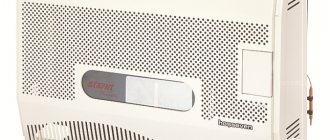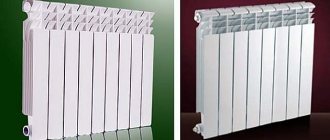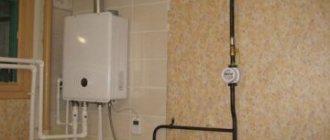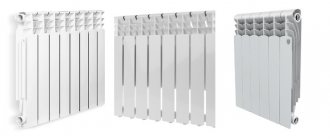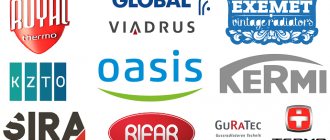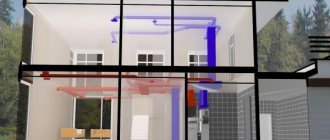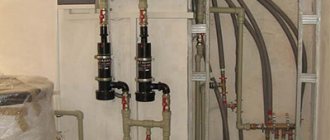During the winter period in Russia, housing needs to be heated even in the southern regions, which determines the demand among our consumers for many types of stationary and portable heating equipment. A large niche in the Russian market of heaters offered by foreign and domestic manufacturers is occupied by a group of infrared devices with a general principle of influencing the environment, but consisting of subgroups that differ in design and, as a result, functionality and efficiency.
Let's take a closer look at one of the types of infrared devices for heating homes - a wall-mounted film heater, which has been used in everyday life relatively recently, but, due to a number of advantages, is already in stable consumer demand.
Operating principle of IR heaters
Infrared rays are non-visible electromagnetic waves with a length from 0.74 microns to 1.5-2 mm. Any heated body becomes a source of infrared radiation - an emitter, and the emitter is heated by converting the energy of one of the types of energy carrier - electric current, gas, solid or liquid fuel - into heat.
Infrared radiation, encountering an obstacle in the path of propagation, causes vibration of its surface layer with an increase in the speed of movement of molecules, which causes an increase in the temperature of the object to a certain depth.
The wavelength range of infrared radiation, in turn, is divided into the following components:
- short-wave – 0.74-2.5 microns;
- average wavelength – 2.5-50.0 microns;
- long-wave – 50.0-2000.0 microns.
The intensity of heating of the surface of objects depends on the temperature of the emitter - the higher it is, the shorter the wavelength of infrared radiation and the greater the depth of heating of the surface of the obstacle. When IR rays propagate, they do not change the temperature characteristics of the transit medium - the air is heated not by their passage, but by the transfer of heat to it by heated objects.
The method of heat transfer through infrared radiation is not associated with conduction or convection, so IR heaters are capable of transferring heat even through a vacuum.
Description
Infrared electric heaters become in demand at a time when it is already cold outside and the central heating has not yet been connected. If you find yourself in such a situation, you can resolve the issue in one of two ways. The first involves the use of a different type of heater, while the second involves the use of infrared devices. Such devices produce thermal energy that passes through the air and heats objects. It is the surfaces that begin to heat up, due to this the room becomes warm. The degree of heating will depend on the shape of the surface, the angle of incidence of the rays, and the materials. Heat is transferred into the air from the objects themselves, and not from the heating device. Infrared electric heaters operate on a principle that involves accumulating heat in the place where it is most needed, namely, near furniture, walls and people in the room. An interesting fact is that the heat released from the heater can be compared to natural solar radiation.
Film electric heater device (PLEN)
*
All IR heaters are divided into high-temperature short-wave and low-temperature long-wave. Film-type heaters belong to the second group.
Visually, a film IR electric heater is a flexible sheet or strip of a certain format. If the model is not decorative (a picture heater), then the transparent outer layers allow you to see the location of the component elements.
Important! PLEN is an abbreviation meaning “film radiant electric heater”, and not a registered trademark.
Structurally, any type of film-type household heater includes the following components:
- resistive type heating elements - made of carbon-containing materials or metals, tape or plate, capable of heating up to 35-55 degrees when an electric current passes through them;
- heat distributing base - one or two layers of thin aluminum foil on which resistors are mounted to evenly distribute the heat from their heating over the surface of the screen;
- thermostat with temperature sensors;
- two protective layers of laminated film with a melting point of up to 210 degrees, between which there is foil with heating elements;
- cable for connecting PLEN to the network.
The total thickness of the heating sheet does not exceed 1.5 mm.
Schematically, PLEN can be depicted as follows (the thermostat is installed separately):
1 – contacts for connecting the device to a 220 V network;
2 – flexible two-layer shell made of polymer film on a supporting lavsan or polyester base;
3 – points of industrial, carefully insulated connection of the supply wire with the contacts of the heaters (independent cable replacement is not provided);
4 – heating resistive elements (tape or separate plates connected by conductors);
5 – aluminum foil;
6 – hologram to protect the heater from counterfeit production.
Manufacturers
Installation of electric heated floors, cable and infrared film
Due to the diversity of the heating appliance market, it is recommended to pay attention to only some manufacturers whose devices are especially popular.
UFO
UFO is a Turkish company that has been producing infrared heaters, air filters and ventilation systems since 1997. The products are manufactured in Turkey and then supplied to many countries around the world. It is noteworthy that the company's main emphasis is on high-power heaters.
Polaris
Polaris is a manufacturing company from the USA that has factories for the production of its products in four countries: Russia, China, Israel and Italy. Products manufactured include: heating devices, water heaters, climate control equipment and small household appliances. Floor-mounted heaters are the most actively produced. In addition, most devices use carbon fiber.
ENSA
ENSA is a Ukrainian manufacturer that creates exclusively infrared heaters. Mostly heating panels are produced that can easily heat small rooms. Features of the products include their low cost - these are the most economical heating devices on the market.
Ballu
Ballu is a manufacturer whose products are the most popular, reliable and affordable. The catalog of manufactured products includes air conditioners, household heaters, water heaters, air filters and a variety of heating equipment. In addition, Ballu, in addition to household heaters, also produces industrial devices with high power and reliability.
Today, Ballu is a transnational manufacturer. The company's factories and branches are located in Taiwan, China and Malaysia.
Operating principle of PLEN
*
When the power cable is connected to the network, the resistive elements heat up to a preset temperature value (35-50 degrees) within 10 seconds. Film heaters for non-domestic purposes (for mini-saunas, dryers of agricultural products), used in rooms with ceiling heights of more than 3.5 m, have resistive elements of wire, tape, plate design made of nichrome, fechral or multicomponent alloys, providing a higher temperature heating
The heat of the heaters is transferred to the foil and, due to the high thermal conductivity of aluminum, is evenly distributed over its surface, which allows the heater to generate IR radiation of equal intensity over its entire area. When the air in the room reaches the set temperature value, the film heater turns off based on a signal from the temperature sensor in the thermostat, and objects heated by radiation continue to give off heat. When the temperature in the room drops by 1 degree, the thermostat will turn on again, and the film heater will perform a new radiation cycle.
A correctly calculated combination of the material of the reflective layer, its thickness, and the arrangement of resistive heaters ensures the conversion of electricity into heat, and then into infrared radiation with a wavelength of 8-15 microns favorable for human perception.
Important! When the current increases or the thermostat fails, the temperature of the resistive graphite heaters will increase, which will lead to their destruction and failure of the household film heater as a whole, that is, the resistive elements also perform the protective function of fuses.
Criterias of choice
To purchase a high-quality unit suitable for a particular home, you need to pay attention to the technical characteristics, as well as the efficiency of the equipment. You can also look at a number of additional functions and the cost of the device
As for the cost, you can choose high-quality models at approximately the same price, which greatly simplifies the choice. If desired, you can find more expensive types of devices equipped with additional functionality.
You need to know that convection and ceramic heaters become ineffective if the house has very high ceilings
This is also worth paying attention to when purchasing.
If the heater needs to be used constantly, then you will need to choose the most powerful models that have a heat sensor, timer, and other useful functions. In this way, system efficiency can be increased and energy consumption can be reduced. But you will have to spend an extra few thousand rubles on such models.
Also, before purchasing, it is advisable to read the reviews of people who have already purchased the equipment and installed it in their home. If a certain model or company has a large number of positive reviews, then this is considered one of the main guidelines when choosing the right unit.
Types of film heater
One of the main differences between film-type electric heaters is their format and size. PLENs are produced in the form of tapes of various lengths and widths. Independent correction of the dimensions of such films is impossible, therefore PLENs are produced in a wide range of dimensions, allowing you to choose the best option. The most common sizes of tapes in width are 35, 51 and 65 cm.
Films with a width of 35 and 51 cm have two zones that are free from the location of resistive elements and are intended for installation using a stapler - along the edges. Ribbons 65 cm wide have three such zones - two at the edges and one along the middle (as an option - two at the edges and between them transverse with a certain pitch).
Flexible film IR heaters can be installed on both vertical and horizontal surfaces - the design of film-type electric heaters does not depend on the location of its installation, with the exception of PLEN-pictures, which by definition should be located in places of the best view - on the walls. The classification of a particular film heater as a wall, floor or ceiling device is determined only by its design location - an important factor affecting the efficiency of this IR device. Thus, a film heater on the wall, after being installed on the ceiling, in everyday life turns into a ceiling heater.
Let's consider options for placing PLENs in premises in order of increasing efficiency of their use.
Wall arrangement of film heaters
*
Placing PLENs on the wall is the least effective due to the limited sector of influence of infrared radiation on the enclosing structures - most of the infrared rays heat the surface of the wall opposite, with almost no effect on the floor and ceiling.
Film devices permanently mounted on the wall are effective as the main means of heating only if the opposite base has a significant area - then the heat transfer from its heated surface into the air will be quite noticeable.
If the area of film heaters installed on the wall is not significant, and the base, on the contrary, also has window openings, then the efficiency of such an IR heater will be low. But small-area stationary wall-mounted film heaters are convenient as an additional means of heating - to increase the comfort of the temperature regime of a certain place or zone in the room.
A type of film-type wall heaters are portable IR devices with artistic decoration that imitate paintings. In order for their use to be rational and effective, picture heaters must be used in small rooms for heating, for example, a workplace, or in groups, the total heat transfer area of which will be commensurate with the size of the room.
Floor placement of film-type IR heaters
Infrared radiation from devices located in this way affects the floor covering and ceiling. A warm floor surface increases the comfort of human contact with it - you can walk without shoes, sit or lie on the floor, etc. In addition, the transfer of heat from the floor to the cold lower layers of air in the room also warms the room, as it causes the occurrence of convective flows. But the energy of that part of the IR rays that penetrates the floor covering is spent on heating the ceiling, which is less efficient - the ceiling base has little need for this, since its temperature is already quite high as a result of convection.
Important! It is not advisable to place film IR heaters in furniture locations - bulky objects made of materials with low thermal conductivity create barriers to infrared radiation.
Ceiling installation of infrared film heaters
When using film-type heating devices as the main means of heating, placing them on the ceiling is the most effective, since this arrangement ensures that all enclosing structures of the room, regardless of configuration, and the objects in it are exposed to radiation.
Important! When choosing a ceiling for installation of PLENs, it is necessary to take into account that the efficiency of heating with IR rays decreases with increasing distance to the emitter. Film-type infrared heaters are low-temperature, long-wave devices, so their use at ceiling heights of more than 3.5 m is irrational.
The advantage of ceiling placement of PLENs, in addition to high heating efficiency, is the minimal risk of accidental damage to the heater, which is located at a fairly safe distance from the traffic zone. However, there are also disadvantages - the location on the ceiling makes the PLEN vulnerable to leakage from above, and installation work at height is more labor-intensive.
Options for using technology
Infrared heating is used quite widely today.
Regardless of whether a person lives in the house permanently or uses the home as a temporary shelter, such devices are ideal for heating living rooms at any time of the year. But this is not the only area of their application. Such units can be used for heating balconies and loggias, unheated garages, dressing rooms, terraces, verandas of open and closed gazebos, greenhouses and winter gardens, chicken coops and other premises for animals.
With the help of such devices, you can very quickly reach the desired room temperature, warm the soil, extend the summer season, reap a good harvest, and achieve amazing results in livestock farming. At the same time, creating a comfortable microclimate will not provoke an increase in electricity costs, which leads to significant financial savings.
Characteristics of an electric heater of film construction.
When choosing a film IR heater, you must be guided not only by its size - PLENs also have other characteristics, including those that are important for specific conditions:
- voltage of current consumption is mainly 220 V, but they are also produced at 110 V;
- power - up to 500 W, energy consumption per square meter of film heater (power density) can range from 70 to 170 W;
- maximum heating temperature – 35-50 degrees;
- current consumption – 0.7-1.2 A;
- specific gravity – up to 350 g/m2.
To make the description clearer, we summarize the data on the characteristics of film heaters in relation to their standard sizes:
*
Home Guardian Angel
The wall heater adds warmth and coziness thanks to the image of a guardian angel.
Heating area - 15 sq.m, power 220 V, maximum heating -100 C. Can be used in an office, garage, loggia, apartment. Attached to the wall with screws.
Advantages:
- does not dry out the air;
- does not burn oxygen;
- decorates the room;
- creates heat;
- does not burn;
- can work around the clock;
- consumes little electricity.
Flaws:
- No.
Installation of film-type IR heaters
Installation of flexible film heaters, regardless of the installation location, does not require the contractor to have high-level professional skills, but must be carried out in compliance with the following rules:
- the installation site of the PLEN must be level and dry;
- cutting rolls, if provided for by the model, should be performed only according to the markings specified by the manufacturer;
- testing the functionality by plugging in a rolled-up heater is prohibited;
- the length of one strip film fragment should not exceed 8 m;
- adjacent strips of the heating system are located at a distance of at least 5 mm;
- bending the PLEN at an angle of more than 90 degrees is not allowed;
- installation of the film to the base is carried out with staples using a construction stapler or special fasteners (the use of ordinary nails and self-tapping screws is not effective);
- It is prohibited to carry out installation work at sub-zero air temperatures - after warming up the room, the film strips will increase in size and form folds.
Sequence of installation of film IR heaters
To protect against overheating, the base for placing the PLEN must be equipped with a foil reflective screen that acts as a heat and water insulator, for example, penofol, isolon.
The protective coating is mounted on the base with an overlap of adjacent edges of 3-5 cm; to speed up the process, it is advisable to use special fasteners for fastening, which are available in a wide range on sale.
From above, the joints of the screen strips are glued longitudinally with special foil tape.
The elements of the film heater are mounted on top of the laid screen - after preliminary layout and in accordance with the installation instructions supplied with the device. Installation is carried out taking into account the rule - for 1 square meter of flexible film there should be 8-10 fastening elements.
When the heating circuit is ready to be installed, it is connected to the thermostat, which should be located at a height of 1-1.5 m from the floor, and the system’s functionality is checked.
In addition, to correctly monitor the temperature in the room, the thermostat must be located away from other heating devices, have a thermal insulation pad underneath, and be protected from direct sunlight and drafts.
If the results of testing the IR device are positive, finishing materials are laid - floor covering or suspended ceiling, which are installed with a gap of 10-15 mm between the cladding and the film.
Important! There are no materials that are absolutely transparent for PLENs - any finishing finish on top of the film is a screen that attenuates radiation to one degree or another.
Read on the topic - how to attach, lay and glue penofol.
Caleo GOLD 230-0.5 230 W
Thin infrared film rolled into a roll. Mat length – 200 cm, width – 50 cm. Heating area – 1 m². Power consumption 230 W. The film is protected from overheating. It is fireproof (has the ability to self-extinguish).
Advantages:
- easy to install;
- heats up quickly;
- warms up large surfaces well;
- turns on and off using a thermostat.
Flaws:
- Doesn't warm up the loggia well enough, but maintains the heat.
Some notes and recommendations for use
- One should not expect high efficiency from film IR heaters, as well as from any other heating units, in the absence of thermal insulation of the housing enclosing structures.
- Marketers' statements about the PLEN wavelength of 8 microns, supposedly optimal for human perception, do not correspond to reality - the radiation of IR heaters is always in a certain range and cannot consist of waves of any one length.
- Installing PLEN in one room, even over the entire area of the enclosing structures, will not solve the problem of heating other rooms for the house.
- The operation of PLEN is not accompanied by a decrease in oxygen in the room air, so there is no need to increase the frequency of room ventilation when using film heaters.
- It is not necessary to turn off the PLEN system in the summer - just set the thermostat to the desired temperature value.
- The durability of infrared film heaters declared by manufacturers (up to 50 years) is a hypothetical value, since PLENs began to be produced relatively recently.
- The safety requirements for household electrical appliances, including film-type ones, are set out in GOST R 52161.2.96-2006.
Purpose
The main purpose of an infrared heater is to expose any absorbing surface to the rays it produces. Such surfaces include any objects around you that absorb light energy, that is, not transparent and the person himself. Due to this property, heating of the surrounding air space is a side effect of the operation of an infrared heater, when thermal energy from heated objects is transferred to the air. This determines the main advantage over classical systems - direct impact on a specific area and the absence of such large losses.
Rice. 1: fundamental difference in heating
In practice, an infrared gas heater is designed to heat any space in places where it is not possible to connect electric convectors to the network or where power supply is impractical.
As specific examples, an IR heater can be used for:
- Heating of gazebos and tables in nature, in park areas and recreation areas, etc.;
- Heating tents in the cold season from a gas cylinder;
- Heating garages to ensure comfortable working conditions;
- Heating of residential premises in summer cottages;
- Ensuring temperature conditions in the working area of industrial premises;
- Heating of greenhouses, chicken coops and nurseries for livestock;
- Heating any area in the open air (at construction sites, quarries, geological exploration sites, terraces, etc.).
Also, using this type of gas heaters, various surfaces can be dried and heated. An important advantage of an infrared gas heater is the use of a special element for burning fuel and producing infrared radiation. This feature makes its operation identical to that of electrical appliances, with the difference that it can function regardless of the presence of a centralized fuel source.
